The Netherlands and several European NATO partner countries have officially abandoned their initiative to acquire six Boeing E-7 Wedgetail airborne warning and control systems (AWACS). This decision marks a significant shift in a collaborative effort involving eight nations, including the United States, aimed at replacing the outdated and less efficient Boeing E-3As, which are set to be retired by 2035.
According to a statement from the Dutch Ministry of Defence, the decision to halt the procurement was primarily influenced by the United States’ withdrawal from the program last July. This exit prompted major disruptions in both the strategic and financial aspects of the initiative, leading to the alliance of remaining countries, known as the Support Partnership Committee, to cease acquisition plans for the E-7.
The US’s retreat from the project was driven by rising costs and concerns regarding survivability. In light of these challenges, the US has opted to reorient its focus towards advancing space-based systems that can enhance the detection and tracking of enemy aircraft. This pivot towards an orbital solution also offers the advantage of global coverage, as opposed to the regional limitations of traditional airborne systems.
A senior US military official emphasized the necessity of substantial investments in space-based sensing technologies, which not only support domestic defense but also address strategic priorities in the Indo-Pacific region. “The investment in Wedgetail was redirected towards space-based sensors,” the official noted. “We believe this capability can be developed faster than the E-7 will be delivered.”
The transition to space-based solutions means that the anticipated capabilities from these investments might not materialize until the early 2030s. In the interim, military planners are considering the Northrop Grumman E-2D Hawkeye uncrewed tactical airborne early warning aircraft as a potential complement to the 16 aging Boeing E-3 Sentries, which have remained operational since the late 1970s.
The Netherlands was part of a broader seven-nation partnership aimed at AWACS replacement, which also included Belgium, Germany, Luxembourg, Norway, Romania, and the US. As the dust settles on this withdrawal, it remains unclear which other nations have decided to abandon the program alongside the Netherlands and the US.
In response to the cancellation, the withdrawing countries are actively seeking alternative solutions and exploring collaborations with European defense partners. The overarching goal remains to field quieter and more advanced aircraft by the 2035 deadline, as highlighted by Gijs Tuinman, State Secretary for Defence of the Netherlands. Tuinman pointed out that the US’s exit underscores the importance of maximizing investments within the European defense industry.
Among the potential alternatives being considered is Saab’s GlobalEye system, a surveillance and command platform built on the Bombardier Global 6000/6500 business jet airframe. France has already earmarked the GlobalEye as a replacement for its E-3F Sentry fleet. Additionally, Sweden has ordered two units with options for two more, while Saab has approached Denmark and Finland for potential joint utilization of this aircraft, further underscoring the ongoing shift towards domestic solutions in European defense initiatives.


















